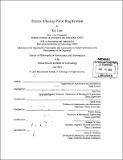| dc.contributor.advisor | Tian Tian. | en_US |
| dc.contributor.author | Liao, Kai, Ph. D. Massachusetts Institute of Technology | en_US |
| dc.contributor.other | Massachusetts Institute of Technology. Department of Aeronautics and Astronautics. | en_US |
| dc.date.accessioned | 2013-11-18T21:45:50Z | |
| dc.date.available | 2013-11-18T21:45:50Z | |
| dc.date.copyright | 2013 | en_US |
| dc.date.issued | 2013 | en_US |
| dc.identifier.uri | http://hdl.handle.net/1721.1/82499 | |
| dc.description | Thesis (Ph. D.)--Massachusetts Institute of Technology, Dept. of Aeronautics and Astronautics, 2013. | en_US |
| dc.description | This thesis was scanned as part of an electronic thesis pilot project. | en_US |
| dc.description | Cataloged from PDF version of thesis. | en_US |
| dc.description | Includes bibliographical references (p. 153-156). | en_US |
| dc.description.abstract | The piston ring pack friction is a major contributor to the internal combustion engine mechanical friction loss. The oil control ring decides the oil supply to the top two rings in addition to being the major friction contributor in the ring pack. This work concentrated on the oil control ring friction. A large range of ring land widths and tensions, liner finish, and oil viscosity were investigated both experimentally and numerically to reveal how different factors affect the piston ring friction. A floating liner engine (FLE) was modified for motoring tests. The engine system repeatability and self-consistency were demonstrated. The thesis then discussed proper methods to select and measure the rings, liners and oil, which were important to generating meaningful results from the experiment. The ranges of engine speeds and liner temperatures were designed to ensure that all the lubrication modes, namely, boundary, mixed and hydrodynamic, can become dominant in both the instantaneous friction over a cycle and the FMEP over the engine speed range for any combination of rings, liners and lubricants. A parallel modeling effort was made to the experiments. The work showed that with careful preparation of adequate information on rings, liners and lubricants, the model can match the friction trends observed in the experiment over a large range of operating parameters and designs on the ring, liner finish and lubricant viscosity. The ring friction change over the liner break-in was studied using liners covering a wide range of surface roughness. The hydrodynamic pressure generation ability of the liner appears to be decided by the large surface structure. Therefore, the break-in process, which removes individual asperities from the plateau, does not affect pure hydrodynamic lubrication, and only the mixed lubrication is affected by the plateau roughness change. By keeping the same hydrodynamic pressure - ring/liner clearance (P-h) correlation and changing the plateau roughness, the model can predict the ring friction change over different lubrication regimes during the break-in. Compared to the current industry norm, a new engine power cylinder system design using a smaller land width twin land oil control ring with a lower ring tension and accompanied by a smoother liner surface gives lower friction and better oil control at the same time. | en_US |
| dc.description.statementofresponsibility | by Kai Liao. | en_US |
| dc.format.extent | 156 p. | en_US |
| dc.language.iso | eng | en_US |
| dc.publisher | Massachusetts Institute of Technology | en_US |
| dc.rights | M.I.T. theses are protected by
copyright. They may be viewed from this source for any purpose, but
reproduction or distribution in any format is prohibited without written
permission. See provided URL for inquiries about permission. | en_US |
| dc.rights.uri | http://dspace.mit.edu/handle/1721.1/7582 | en_US |
| dc.subject | Aeronautics and Astronautics. | en_US |
| dc.title | Factors affecting piston ring friction | en_US |
| dc.type | Thesis | en_US |
| dc.description.degree | Ph.D. | en_US |
| dc.contributor.department | Massachusetts Institute of Technology. Department of Aeronautics and Astronautics | |
| dc.identifier.oclc | 862431561 | en_US |
